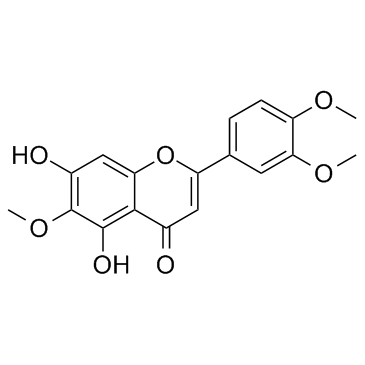
Eupatilin
CAS No. 22368-21-4
Eupatilin( NSC 122413 | Stillen )
Catalog No. M13588 CAS No. 22368-21-4
Eupatilin (NSC 122413, Stillen) is a pharmacologically active flavone derived from Artemisia plants, possess anti-inflammatory, anti-oxidative and anti-cancer activities.
Purity : >98% (HPLC)
 COA
COA
 Datasheet
Datasheet
 HNMR
HNMR
 HPLC
HPLC
 MSDS
MSDS
 Handing Instructions
Handing Instructions
| Size | Price / USD | Stock | Quantity |
| 5MG | 55 | In Stock |


|
| 10MG | 96 | In Stock |


|
| 25MG | 195 | In Stock |


|
| 50MG | 344 | In Stock |


|
| 100MG | 506 | In Stock |


|
| 200MG | Get Quote | In Stock |


|
| 500MG | Get Quote | In Stock |


|
| 1G | Get Quote | In Stock |


|
Biological Information
-
Product NameEupatilin
-
NoteResearch use only, not for human use.
-
Brief DescriptionEupatilin (NSC 122413, Stillen) is a pharmacologically active flavone derived from Artemisia plants, possess anti-inflammatory, anti-oxidative and anti-cancer activities.
-
DescriptionEupatilin (NSC 122413, Stillen) is a pharmacologically active flavone derived from Artemisia plants, possess anti-inflammatory, anti-oxidative and anti-cancer activities; induces cell cycle arrest in ras-transformed human mammary epithelial cells; attenuates aortic smooth muscle cell proliferation and migration by inhibiting PI3K, MKK3/6, and MKK4 activities; inhibits angiogenesis-mediated human hepatocellular metastasis by reducing MMP-2 and VEGF signaling.(In Vitro):Eupatilin is a PPARα agonist. Eupatilin (10, 30, 100 μM) suppresses IL-4 expression and degranulation in RBL-2H3 cells. Eupatilin (50-100 μM) slightly reduces cell viability of HaCaT cells. Eupatilin (10, 30, 50, 100 μM) increases PPARα transactivation and expression in HaCaT cells. Eupatilin (10, 30, 50 μM) also suppresses TNFα-induced MMP-2/-9 expression in HaCaT cells. Furthermore, Eupatilin inhibits TNFα-induced p65 translocation, IκBα Phosphorylation, AP-1 and MAPK signaling via PPARα. Eupatilin (10-50 μM) shows no cytotoxic effects on ARPE19 cells. Eupatilin (10, 25, 50 μM) elevates cell viability from oxidative stress, and inhibits H2O2-induced ROS production in ARPE19 cells. Moreover, Eupatilin (50 μM) inbibits H2O2-induced cells apoptosis and promotes the activation of PI3K/Akt pathway in RPE cells. (In Vivo):Eupatilin (1.5% or 3.0%) restores PPARα mRNA expression, and improves atopic dermatitis (AD)-like symptoms in oxazolone-induced Balb/c mice. Eupatilin causes significant decrease in serum IgE, IL-4 levels, oxazolone-induced TNFα, IFNγ, IL-1β, TSLP, IL-33 and IL-25 mRNA expression in oxazolone-induced mice. Eupatilin also increases filaggrin and loricrin mRNA expression in oxazolone-induced mice.
-
In Vitro——
-
In Vivo——
-
SynonymsNSC 122413 | Stillen
-
PathwayNatural Products
-
TargetFlavonoids
-
RecptorOthers
-
Research AreaOther Indications
-
Indication——
Chemical Information
-
CAS Number22368-21-4
-
Formula Weight344.32
-
Molecular FormulaC18H16O7
-
Purity>98% (HPLC)
-
SolubilityDMSO: 62 mg/mL (180.1 mM) ( < 1 mg/ml refers to the product slightly soluble or insoluble )
-
SMILESCOC1=C(C=C(C=C1)C2=CC(=O)C3=C(C(=C(C=C3O2)O)OC)O)OC
-
Chemical Name2-(3,4-Dimethoxyphenyl)-5,7-dihydroxy-6-methoxy-4H-1-benzopyran-4-one
Shipping & Storage Information
-
Storage(-20℃)
-
ShippingWith Ice Pack
-
Stability≥ 2 years
Reference
1. Kim DH, et al. Biochem Pharmacol. 2004 Sep 15;68(6):1081-7.
2. Koshihara Y, et al. FEBS Lett. 1983 Jul 11;158(1):41-4.
3. Son JE, et al. Planta Med. 2013 Aug;79(12):1009-16.
4. Park JY, et al. Bioorg Med Chem Lett. 2018 Oct 15;28(19):3150-3154.
molnova catalog



related products
-
Luteolinidin chlorid...
Luteolinidin is a natural deoxyanthocyanidin, isolated from mosses and ferns.
-
Jaceosidin
Jaceosidin (4'-Demethyleupatilin, Jaseocidin) is a trihydroxyflavone that exhibits anti-allergic, anti-inflammatory and apoptosis inducing activties.
-
Theaflavin-3-gallate
Theaflavin-3-gallate, a black tea theaflavin monomer, is regarded as the biologically important active component of black tea and provides health benefits.



 Cart
Cart
 sales@molnova.com
sales@molnova.com


